
Anoa, also known as dwarf buffalo and sapiutan, are two species of the genus Bubalus, placed within the subgenus Anoa and endemic to the island of Sulawesi in Indonesia: the mountain anoa and the lowland anoa. Both live in undisturbed rainforests and are similar in appearance to miniature water buffaloes, weighing 150–300 kg (330–660 lb).
Buffalo most commonly refers to:

The water buffalo, also called the domestic water buffalo or Asian water buffalo, is a large bovid originating in the Indian subcontinent and Southeast Asia. Today, it is also found in Italy, the Balkans, Australia, North America, South America and some African countries. Two extant types of water buffalo are recognized, based on morphological and behavioural criteria: the river buffalo of the Indian subcontinent and further west to the Balkans, Egypt and Italy and the swamp buffalo, found from Assam in the west through Southeast Asia to the Yangtze Valley of China in the east.

Bovines comprise a diverse group of 10 genera of medium to large-sized ungulates, including cattle, bison, African buffalo, water buffalos, and the four-horned and spiral-horned antelopes. The evolutionary relationship between the members of the group is still debated, and their classification into loose tribes rather than formal subgroups reflects this uncertainty. General characteristics include cloven hooves and usually at least one of the sexes of a species having true horns. The largest extant bovine is the gaur.

Bubalus is a genus of Asiatic bovines that was proposed by Charles Hamilton Smith in 1827. Bubalus and Syncerus form the subtribe Bubalina, the true buffaloes.

Carabaos are a genetically distinct population of swamp-type water buffaloes from the Philippines. They descended from domesticated swamp buffalo populations from Taiwan that were introduced to the Philippines in the Neolithic via the Austronesian expansion. They were also further introduced to Sulawesi and Borneo of eastern Indonesia and Malaysia.

The tamaraw or Mindoro dwarf buffalo is a small buffalo belonging to the family Bovidae. It is endemic to the island of Mindoro in the Philippines, and is the only endemic Philippine bovine. It is believed, however, to have once also thrived on the larger island of Luzon. The tamaraw was originally found all over Mindoro, from sea level up to the mountains, but because of human habitation, hunting, and logging, it is now restricted to only a few remote grassy plains and is now a critically endangered species.
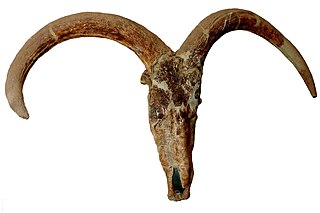
Pelorovis is an extinct genus of African wild cattle which existed during the Pleistocene epoch. The best known species is Pelorovis oldowayensis from Olduvai Gorge in Tanzania, from the Early Pleistocene. The species "Pelorovis" antiquus from the Late Pleistocene-Holocene has since been moved into Syncerus, the same genus as living African buffalo.
The Cebu tamaraw is a fossil dwarf buffalo discovered in the Philippines, and first described in 2006.

Haematopinus is a genus of insects in the superfamily Anoplura, the sucking lice. It is the only genus in the family Haematopinidae, known commonly as the ungulate lice. All known species are of importance in veterinary medicine. These lice are some of the most economically important ectoparasites of domestic animals. Species infest many domesticated and wild large mammals, including cattle, horses, donkeys, swine, water buffalo, African buffalo, antelope, zebra, deer, and camels. The species Haematopinus tuberculatus has great importance in the water buffalo breading, since this louse is specific to buffaloes, being the main ectoparasite of the species, with important sanitary and economic burden. The Haematopinus tuberculatus is suspected to be involved in the transmission of diseases, such as anaplasmosis. The parasites are found infesting buffaloes in greater concentrations around the ears, base of horns, side of the neck, around the scrotum or udder, and especially at the tip of the tail.
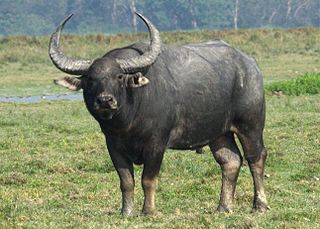
The wild water buffalo, also called Asian buffalo, Asiatic buffalo and wild buffalo, is a large bovine native to the Indian subcontinent and Southeast Asia. It has been listed as Endangered in the IUCN Red List since 1986, as the remaining population totals less than 4,000. A population decline of at least 50% over the last three generations is projected to continue. The global population has been estimated at 3,400 individuals, of which 3,100 (91%) live in India, mostly in Assam. The wild water buffalo is the most likely ancestor of the domestic water buffalo.
The water buffalo is a domesticated bovid widely kept in Asia, Europe and South America.
Elaeophora poeli is a parasitic nematode found in the aorta, and sometimes the heart, of various cattle throughout Asia, and in parts of Africa. It is a large nematode, with males measuring 45–70 mm long and 200-260 μm wide, and females 40–300 mm long and 350 μm wide. Microfilariae are 340-346 μm long and 7.0-7.5 μm wide. Despite the fact that it lives in nodules (aneurysms) in the walls of the aorta and heart, apparent clinical symptoms of E. poeli infestation are seldom reported.
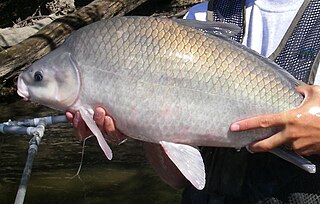
The smallmouth buffalo is one of the longest-lived fishes, capable of living more than a century. They are a catostomid fish species native to the major tributaries and surrounding waters of the Mississippi River in the United States, as well as some other water systems where it has been introduced. It is a long-lived, stocky fish like its relatives the bigmouth buffalo and the black buffalo. The smallmouth buffalo's mouth is located ventrally like other Catostomidae species, whereas the bigmouth buffalo's mouth is terminal and opens forward. It is thought that smallmouth buffalo eyes are significantly larger than those of the black buffalo. Despite being members of different scientific families, these three species superficially resemble the common carp, but an easy and notable difference is that all catostomids lack the characteristic barbels of carp.

Syncerus antiquus is an extinct species of buffalo from the Late Pleistocene and Holocene of Africa. It was one of the largest species in its family, potentially weighing up to 2,000 kilograms (4,400 lb). Due to this fact, it is sometimes known as the African giant buffalo. The time of its extinction is of debate; Syncerus antiquus either became extinct at the end of the Late Pleistocene about 12,000 years ago or during the Holocene, some 4,000 years ago.

The mountain anoa(Bubalus quarlesi) also known as Quarle's anoa, is a species of buffalo endemic to Sulawesi. Its closest relative is the lowland anoa, and it is still a debate as to whether the two are the same species or not. It is also related to the water buffalo, and both are classified in the genus Bubalus.

The lowland anoa(Bubalus depressicornis) is a species of buffalo endemic to Sulawesi. Its closest relative is the mountain anoa, and it is still a debate as to whether the two are the same species or not. It is also related to the water buffalo, and both are classified in the genus Bubalus.

Bubalus murrensis, also known as European water buffalo, is an extinct buffalo species native to Europe during the Pleistocene epoch, possibly persisting into the Holocene. It was a close relative of both the wild and domestic water buffalo, and may have contributed to some European breeds of water buffalo.
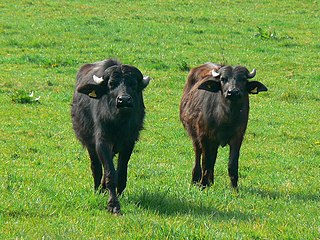
Buffalo meat, also known as buffen, is the meat of the water buffalo, a large bovid, raised for its milk and meat in many countries including India, Nepal, Pakistan, Bangladesh, the Philippines, Bulgaria, Italy, Russia, the Czech Republic, Slovakia, Australia and Egypt.
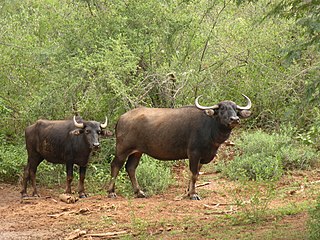
Bubalina is a subtribe of wild cattle that includes the various species of true buffalo. Species include the African buffalo, the anoas, and the wild water buffalo. Buffaloes can be found naturally in sub-Saharan Africa, South Asia and Southeast Asia, and domestic and feral populations have been introduced to Europe, the Americas, and Australia. In addition to the living species, bubalinans have an extensive fossil record where remains have been found in much of Afro-Eurasia.















